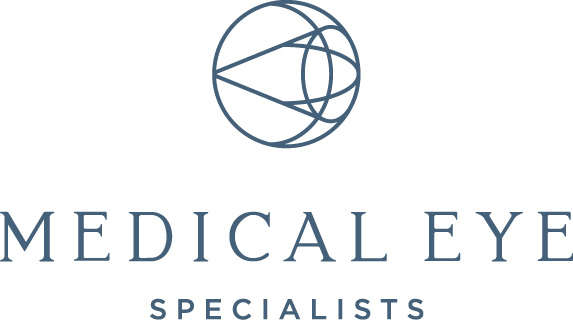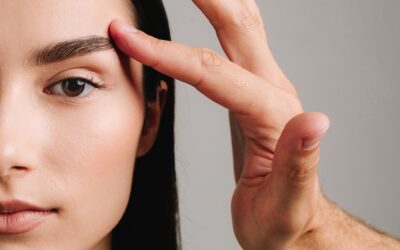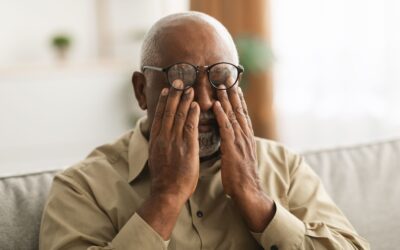Blue light glasses are everywhere these days. They’re all the rage online and in brick-and-mortar optical shops. But what are they? Do they work? Do you need them? Let’s look at the facts behind the hype.
What is blue light?
The sunlight that illuminates our world is actually a spectrum of visible colors that blend together to make white light. You’ve probably heard the acronym ROY G BIV. Those are the hues of the rainbow—red, orange, yellow, green, blue, indigo, violet.
Each of these colors is a unique wavelength of electromagnetic radiation. Blue light is in the shorter wavelength range. It contains more energy per unit of light—or photon—than light in the larger wavelength ranges (red, orange, yellow and green).
Most of the blue light we take in comes to us naturally, from the sun. Indoors, LED and compact fluorescent lightbulbs and our device screens—including computers, tablets and smartphones—produce significant levels of blue light.
Is blue light good or bad?
We know that ultraviolet light from the sun—which is invisible to the human eye and comes in an even shorter wavelength range than blue light—can damage the eye. Over time, exposure to too much UV light raises the risk of eye problems such as cataracts and eye cancer.
But there is no scientific evidence that blue light causes similar eye damage. In fact, exposure to blue light during the day increases alertness, enhances the brain’s cognitive and memory powers and lifts mood. These effects also help us maintain a healthy circadian rhythm, which is our body’s sleep-wake cycle. What’s more, studies have shown that when children don’t get enough outdoor exposure to sunlight, they’re at higher risk of developing nearsightedness.
But blue light at night is a different story. It tells our bodies to be wakeful during the day, and if we continue to take in a lot of electronic blue light after dark, we’re continuing to stimulate our bodies and suppress melatonin production. This can make it harder for us to fall asleep. That’s why doctors at the American Academy of Ophthalmologists recommend limiting evening screen time within the two to three hours before you go to bed.
So electronic devices don’t hurt our eyes?
Most of us are spending a lot of time using electronic devices these days—both for work and relaxation. The blue light they emit may not be damaging our eyes, but the eye strain they cause can temporarily affect our vision and feel uncomfortable.
Digital eye strain, also called computer vision syndrome, can result in symptoms such as blurred vision, achy or irritated eyes, and pain in the back, shoulders, neck or head.
To ease eye strain caused by electronic device use, follow these guidelines:
- Sit 25 inches—or an arm’s length—away from your computer screen, and tilt the screen so that you’re looking slightly downwards at it, not upwards or straight at it.
- Eliminate any sunlight or artificial light causing glare on your screen.
- Hold up a piece of white copy paper in front of your screen and set your display lighting so its brightness matches the color of the paper. If your screen glows brighter than its surroundings, your eyes have to work harder to focus on it.
- Blink more often. People normally blink about 15 times a minute, but when we’re using our devices, we blink about half as much. This causes our eyes to dry out, which makes them irritated and feel fatigued and uncomfortable. Use artificial tears eye drops as needed.
- Follow the 20-20-20 rule: Every 20 minutes, redirect your gaze to look at an object 20 feet away for 20 seconds. Why 20 seconds? Because that’s how long it takes for the muscles in our eyes to completely relax. To help you remember to take eye breaks, set an alert to remind you every 20 minutes.
What about blue light lenses?
Blue light lenses are eyeglasses that claim to filter out light in the blue-wavelength spectrum. But since there is no scientific evidence that blue light damages the eye or that blue light-blocking lenses lessen digital eyestrain, the American Academy of Ophthalmology does not recommend wearing blue light glasses.
Instead, follow the digital eye strain guidelines mentioned above. And to prevent any sleep-cycle disruptions potentially caused by blue light use, minimize the use of electronic devices within the two to three hour window before bedtime and/or set your devices to night mode, which shifts the display colors to the red/orange/yellow end of the light spectrum.
As always, if you’re having any bothersome or painful eye symptoms, it’s best to get them checked out. We at Medical Eye Specialists look forward to helping you safeguard and correct all aspects of your vision so you can live your life to the fullest.
Schedule your next eye exam today.
Comprehensive Eye Care
From routine eye care to medical and surgical eye treatment, our ophthalmologists and optometrists are focused on your vision and the health of your whole eye.




